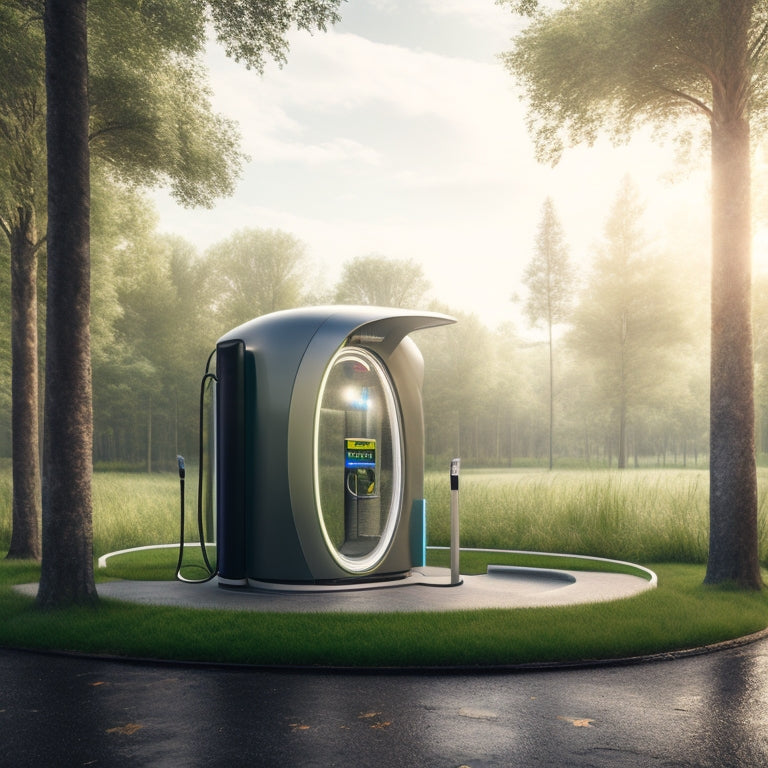
What Makes Effective Electric Vehicle Charging Station Design?
Share
As you design an electric vehicle charging station, you're not just building an infrastructure, you're crafting a user experience that balances functionality, safety, and sustainability. Accessibility and visibility matter, so prioritize clear signage, strategic placement, and stress-free navigation. Fast charging speeds and optimized capacity reduce wait times and enhance user satisfaction. Don't forget essential safety features, a harmonious urban fit, and seamless tech integration. By considering these key elements, you'll create an effective EV charging station that exceeds user expectations. And as you dig deeper, you'll uncover more insights to elevate your design.
Key Takeaways
• Effective EV charging station design prioritizes accessibility and visibility, placing charging points strategically for a stress-free user experience.
• Fast charging speeds and optimized station capacity reduce wait times, enhancing user satisfaction and efficiency for EV owners.
• Integrating safety features, surveillance systems, and emergency response plans ensures a secure environment for users.
• Aesthetically pleasing designs that blend into the urban landscape, incorporating sustainable elements, create a positive user experience.
• Seamless technology integration, real-time monitoring, and robust cybersecurity protocols enable efficient and secure EV charging operations.
Accessibility and Visibility Matters
When designing an electric vehicle charging station, it's important to prioritize accessibility and visibility to guarantee a seamless user experience. A well-placed and easily accessible charging point can greatly reduce congestion and waiting times.
As you plan your charging station, consider the flow of traffic and pedestrian pathways. You want to make sure that drivers can easily navigate to and from the charging points without obstruction. Clear signage is also vital, as it will help guide drivers to available charging spots and reduce confusion.
By incorporating clear signage and well-designed pedestrian pathways, you can create a stress-free experience for EV owners. This thoughtful design won't only improve the overall user experience but also increase the efficiency of your charging station.
Charging Speed and Capacity
You'll need to take into account the charging speed and capacity of your station, as they directly impact the user experience, with faster chargers and higher capacities reducing wait times and increasing user satisfaction. Fast charging capabilities, in particular, are essential for EV owners who need a quick top-up.
When designing your station, consider the following charging levels and their corresponding speeds:
| Charging Level | Power Output | Charging Time |
|---|---|---|
| Level 1 (120V) | 1.4 kW | 24 hours for 100 miles |
| Level 2 (240V) | 7.2 kW | 4 hours for 100 miles |
| DC Fast Charging | 50 kW | 30 minutes for 100 miles |
| High-Power DC Fast Charging | 150 kW | 15 minutes for 100 miles |
Optimizing your charging station's capacity is also essential, as it affects the number of vehicles that can be charged simultaneously. By incorporating fast charging and level optimization strategies, you can create a seamless and efficient charging experience for EV owners.
Safety Features and Surveillance
To guarantee a secure and reliable charging experience, integrating safety features and surveillance systems into your electric vehicle charging station design is vital. You want to make sure that your station is equipped to handle any unexpected events, and that's where emergency response planning comes in. Develop a thorough plan that outlines procedures for emergency situations, such as fires or electrical shocks. This plan should include clear guidelines for emergency responders, station staff, and users.
Installing surveillance cameras and alarm systems will also enhance the overall safety of your station. A secure perimeter is essential to prevent unauthorized access and potential theft or vandalism. Consider implementing access control systems, such as gates or turnstiles, to regulate who can enter the station.
Additionally, make sure that your station is well-lit, with adequate lighting to deter criminal activity and provide a sense of security for users. By incorporating these safety features and surveillance systems, you'll create a safe and trustworthy environment for electric vehicle owners to charge their vehicles.
Aesthetics and Urban Integration
As you shift focus from ensuring safety and security to creating an inviting atmosphere, consider how your electric vehicle charging station's design can harmoniously blend into the surrounding urban landscape. A well-designed charging station should complement the urban environment, incorporating elements of urban landscaping to create a visually appealing space. This can be achieved by incorporating greenery, public art, or other design elements that reflect the local aesthetic.
Critical branding is also vital in creating a cohesive and recognizable brand identity. Consistent use of color schemes, typography, and imagery can create a sense of familiarity and trust among users. Additionally, incorporating sustainable and eco-friendly design elements can reinforce the eco-conscious values of electric vehicle owners.
Technology and Data Integration
Effective integration of technology and data systems enables seamless communication between your electric vehicle charging station and the vehicles it serves, facilitating efficient charging operations and valuable insights into user behavior.
As you design your station, consider the significance of cloud connectivity, which allows for real-time monitoring, remote software updates, and data analytics. This connectivity enables you to track usage patterns, optimize energy distribution, and identify areas for improvement.
Additionally, implementing robust cybersecurity protocols is essential to protect sensitive user data and prevent potential security breaches. You'll want to make sure your system is equipped with encryption, secure authentication, and access controls to safeguard your users' information.
Frequently Asked Questions
Can EV Charging Stations Be Installed in Residential Areas?
You can install EV charging stations in residential areas, but you'll need to take into account homeowner incentives, neighborhood aesthetics, and zoning regulations to guarantee a seamless integration that benefits everyone involved.
Do EV Charging Stations Require Special Electrical Infrastructure?
You'll need to verify that the electrical infrastructure can support the increased power demand, as EV charging stations require a robust power distribution system and sufficient grid capacity to handle the added load.
Can Non-Ev Owners Use EV Charging Station Parking Spaces?
You'll be interested to know that 80% of EV owners charge at home, but when you're out, can you snag an EV charging station parking spot if you don't own an EV? Typically, no, as parking restrictions apply, ensuring public accessibility for actual EV owners.
How Do EV Charging Stations Handle Peak Usage Hours?
As you navigate peak usage hours, you'll notice EV charging stations employ peak management strategies, such as load balancing, to distribute power efficiently, ensuring a seamless charging experience for all users.
Can EV Charging Stations Be Used for Advertising and Branding?
As you pull into the charging station, you're greeted by sleek digital displays, beckoning you to indulge in brand partnerships that seamlessly integrate with your eco-friendly lifestyle, making the wait a breeze.
Related Posts
-

What Does Solar Panel Maintenance Really Cost?
You can expect to pay between $1,500 to $2,500 per year for solar panel maintenance, with costs influenced by your sy...
-

Why Go Solo in Urban Transportation?
You're taking control of your daily commute by ditching the crowds and going solo, and that's a smart move. By choosi...
-

Why Home Battery Deals Are Worth Buying Online
You're buying a home battery deal online for the same reason you wouldn't buy a car without researching online first....


